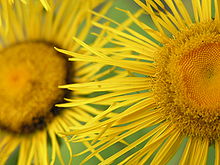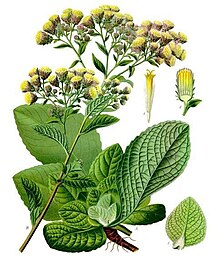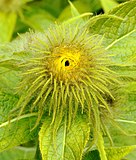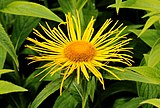Inula
| Inula | |
|---|---|

| |
| Inula helenium[1] | |
| Scientific classification | |
| Kingdom: | Plantae
|
| (unranked): | Angiosperms
|
| (unranked): | |
| (unranked): | |
| Order: | |
| Family: | |
| Subfamily: | |
| Tribe: | Inuleae[2]
|
| Genus: | Inula |
| Synonyms[2] | |
| |



Inula is a large genus of about 90 species of flowering plants in the family Asteraceae, native to Europe, Asia and Africa.
They may be annuals, herbaceous perennials or subshrubs that vary greatly in size, from small species a few centimeters tall to enormous perennials over 3 m (10 ft) tall. They carry yellow daisy-like composite flowerheads often with narrow ray-florets.
Some common characteristics include pappus with bristles, flat capitulum, and lack of chaff.
Several species are popular flowers for the garden, with cultivation going back to antiquity. The smaller species are used in rock gardens and the more common larger ones, which tend to have very coarse foliage, in borders.
Etymology[]
The genus name Inula, of uncertain origin, was already used by the Romans. The Latin phrase inula campana (field inula) gave rise to the English elecampane whose scientific name is Inula helenium. The plant's specific name, helenium, derives from Helen of Troy; elecampane is said to have sprung up from where her tears fell.[3]
Selected species[]
- Schott & Kotschy ex Tchihat. – stemless inula
- S.Moore
- Gand.
- DC.
- Boiss.
- Boiss. & Balansa
- (L.) L.
- Inula britannica L. – British yellowhead
- (L.) Cass.
- (Buch.-Ham. ex D. Don) DC.
- Blume
- ( Hook.f.) R.R.Stewart
- Inula conyzae (Griess.) Meikle – ploughman's-spikenard
- Inula crithmoides L. – golden samphire (syn. Limbarda crithmoides (L.) Dum.)
- L.
- DC.
- Hook.f.
- L.
- Schrenk ex Fisch. & C. A. Mey.
- DC.
- Inula helenium L. – elecampane
- Weber
- Inula hirta L.
- Inula hookeri C. B. Clarke
- R.Dawar & Qaiser
- Turcz.
- Inula magnifica
- L.
- Boiss.
- A.Kern.
- L.
- Lam.
- Inula racemosa Hook.f.
- Schrenk ex Fisch. & C. A. Mey.
- Inula salicina L. – Irish fleabane, willowleaf yellowhead
- Inula spiraeifolia L.
- Abid & Qaiser
- Rech.f.
- Spreng.
- (Willd.) Hausskn.
Select species formerly in Inula[]
- Inula dysenterica L. => Pulicaria dysenterica (L.) Bernh.
- Inula graminifolia Michx. => Pityopsis graminifolia (Michx.) Nutt.
- Inula graveolens (L.) Desf. => Dittrichia graveolens (L.) Greuter – stinkwort, stinkweed
- Inula indica L. => (L.) Y.Ling
- Inula mariana L. => Chrysopsis mariana (L.) Elliott
- Inula primulifolia Lam. => (Lam.) Cuatrec. & Lourteig
- Inula subaxillaris Lam. => Heterotheca subaxillaris (Lam.) Britton & Rusby
- Inula viscosa => Dittrichia viscosa – false yellowhead, sticky fleabane, woody fleabane
Ecology[]
Inula species are used as food plants by the larvae of some Lepidoptera species including case-bearers of the genus Coleophora, such as C. conyzae (recorded on I. conyzae), C. follicularis, C. inulae, and C. troglodytella.
Gallery[]

Inula hookeri. Budding flower bud.
Inula hookeri. Inflorescence.
References[]
- ^ 1897 illustration from Franz Eugen Köhler, Köhler's Medizinal-Pflanzen
- ^ a b "Flann, C (ed) 2009+ Global Compositae Checklist". Archived from the original on 2014-12-09. Retrieved 2014-12-09.
- ^ Melderis, A. (2007). A Handbook of British Flowering Plants. READ BOOKS. p. 271. ISBN 1-4067-6632-1. Retrieved 2009-04-13.
External links[]
| Wikimedia Commons has media related to Inula. |
- Flora Europaea: Inula
- Flora of China: list of Chinese Inula species
- Anderberg, A. (1991). "Taxonomy and phylogeny of tribe Inuleae (Asteraceae)". Pl. Syst. Evol. 176 (1–2): 75–123. doi:10.1007/BF00937947.
- Rubina Abid and M. Qaiser (2003). "Chemotoxonomic study of Inula L. (s.str.) and its allied genera (Inuleae - Compositae) from Pakistan and Kashmir". Pak. J. Bot. 35 (2): 127–140.
- Inula
- Inuleae
- Asteraceae genera

